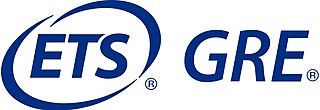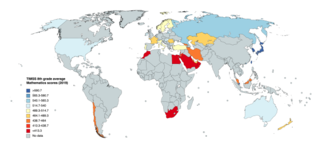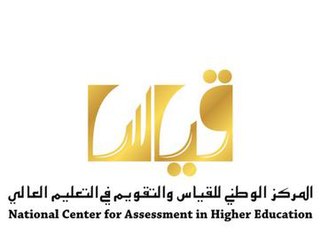Related Research Articles

Educational psychology is the branch of psychology concerned with the scientific study of human learning. The study of learning processes, from both cognitive and behavioral perspectives, allows researchers to understand individual differences in intelligence, cognitive development, affect, motivation, self-regulation, and self-concept, as well as their role in learning. The field of educational psychology relies heavily on quantitative methods, including testing and measurement, to enhance educational activities related to instructional design, classroom management, and assessment, which serve to facilitate learning processes in various educational settings across the lifespan.

A standardized test is a test that is administered and scored in a consistent, or "standard", manner. Standardized tests are designed in such a way that the questions and interpretations are consistent and are administered and scored in a predetermined, standard manner.
Test of English as a Foreign Language is a standardized test to measure the English language ability of non-native speakers wishing to enroll in English-speaking universities. The test is accepted by more than 11,000 universities and other institutions in over 190 countries and territories. TOEFL is one of several major English-language tests worldwide, including IELTS, Duolingo English Test, Cambridge Assessment English, and Trinity College London exams.

In science education, a word problem is a mathematical exercise where significant background information on the problem is presented in ordinary language rather than in mathematical notation. As most word problems involve a narrative of some sort, they are sometimes referred to as story problems and may vary in the amount of technical language used.

The Graduate Record Examinations (GRE) is a standardized test that is an admissions requirement for many graduate schools in the United States and Canada and a few other countries. The GRE is owned and administered by Educational Testing Service (ETS). The test was established in 1936 by the Carnegie Foundation for the Advancement of Teaching.

Problem-based learning (PBL) is a student-centered pedagogy in which students learn about a subject through the experience of solving an open-ended problem found in trigger material. The PBL process does not focus on problem solving with a defined solution, but it allows for the development of other desirable skills and attributes. This includes knowledge acquisition, enhanced group collaboration and communication.
Principles and Standards for School Mathematics (PSSM) are guidelines produced by the National Council of Teachers of Mathematics (NCTM) in 2000, setting forth recommendations for mathematics educators. They form a national vision for preschool through twelfth grade mathematics education in the US and Canada. It is the primary model for standards-based mathematics.
Everett Franklin Lindquist was a professor of education at the University of Iowa College of Education. He is best known as the creator of the ACT and other standardized tests. His contributions to the field of educational testing are significant and still evident today.

Quantitative psychology is a field of scientific study that focuses on the mathematical modeling, research design and methodology, and statistical analysis of psychological processes. It includes tests and other devices for measuring cognitive abilities. Quantitative psychologists develop and analyze a wide variety of research methods, including those of psychometrics, a field concerned with the theory and technique of psychological measurement.
The Iowa Assessments also known informally as the Iowa Tests, formerly known as the ITBS tests or the Iowa Basics, are standardized tests provided as a service to schools by the College of Education of the University of Iowa. Developers Everett Franklin Lindquist, Harry Greene, Ernest Horn, Maude McBroom, and Herbert Spitzer first designed and administered the tests in 1935 as a tool for improving student instruction. The tests are administered to students in kindergarten through eighth grade as part of the Iowa Statewide Testing Programs, a division of the Iowa Testing Programs (ITP). Over decades, participation expanded and currently nearly all school districts in Iowa participate annually in the program, as do many other school districts across the United States. In a cooperative relationship, participating schools receive ITBS test materials, scoring and reporting services and consultation in the use of ITBS for instructional purposes, and ITP utilizes participation by schools in research and test development. Both the ITBS and Iowa Tests of Educational Development (ITED) were revised in the 2011–2012 school year. They were rebranded the Iowa Assessments. In 2016–2017, Iowa Assessments will roll out their new testing program, Next Generation Iowa Assessments.

The IEA's Trends in International Mathematics and Science Study (TIMSS) is a series of international assessments of the mathematics and science knowledge of students around the world. The participating students come from a diverse set of educational systems in terms of economic development, geographical location, and population size. In each of the participating educational systems, a minimum of 4,000 to 5,000 students is evaluated. Contextual data about the conditions in which participating students learn mathematics and science are collected from the students and their teachers, their principals, and their parents via questionnaires.
Math wars is the debate over modern mathematics education, textbooks and curricula in the United States that was triggered by the publication in 1989 of the Curriculum and Evaluation Standards for School Mathematics by the National Council of Teachers of Mathematics (NCTM) and subsequent development and widespread adoption of a new generation of mathematics curricula inspired by these standards.
Connected Mathematics is a comprehensive mathematics program intended for U.S. students in grades 6-8. The curriculum design, text materials for students, and supporting resources for teachers were created and have been progressively refined by the Connected Mathematics Project (CMP) at Michigan State University with advice and contributions from many mathematics teachers, curriculum developers, mathematicians, and mathematics education researchers.
Curriculum-based measurement, or CBM, is also referred to as a general outcomes measures (GOMs) of a student's performance in either basic skills or content knowledge.
The California Basic Educational Skills Test (CBEST) is a standardized test administered in the state of California. It is available as an option in Oregon and Nevada. The test is intended to score basic proficiency in reading, mathematics, and writing. The test is divided into three sections: the reading and math sections each containing 50 multiple-choice questions; and the writing section, consisting of two essay questions. The entire test must be completed in four hours, and test-takers may allocate the time to each section at their discretion. There is no limit to the number of times the test may be taken. Test-takers do not have to pass all three sections in one sitting. A $41 registration fee for paper-based testing must be paid each time the test is taken.
In the United States education system, School Psychological Examiners assess the needs of students in schools for special education services or other interventions. The post requires a relevant postgraduate qualification and specialist training. This role is distinct within school psychology from that of the psychiatrist, clinical psychologist and psychometrist.

Measurement is derived from the verb 'to measure' which means to assess something; in Arabic 'yaqees' 'measure' has the meaning of comparing something to something else. In this sense, measurement is a daily practice that manifests itself in all our assessment activities, whether we assess concrete things in terms of size and color, or abstract things such as human relations. The ultimate goal of 'measuring' something is to assess ourselves in comparison to everything else in the world.
ACT, Inc. is an American 501(c)(3) nonprofit organization, primarily known for the ACT, a standardized test designed to assess high school students' academic achievement and college readiness. For the U.S. high school graduating class of 2019, 52 percent of graduates had taken the ACT test; the more than 1.78 million students included virtually all high school graduates in 17 states.
Computational Psychometrics is an interdisciplinary field fusing theory-based psychometrics, learning and cognitive sciences, and data-driven AI-based computational models as applied to large-scale/high-dimensional learning, assessment, biometric, or psychological data. Computational psychometrics is frequently concerned with providing actionable and meaningful feedback to individuals based on measurement and analysis of individual differences as they pertain to specific areas of enquiry.
The National Educational Development Tests (NEDT) were standardized tests administered in the United States to students in Grades 7 to 10. The test system was developed by Science Research Associates in 1959, and applied from 1960 through to the early 1990s. The structure of the tests was based on the Iowa Tests of Educational Development (ITED) created by the University of Iowa College of Education in 1942 for use in Iowa, and comprised 20–40 minute timed sub-tests in five categories: English Usage, Mathematics Usage, Natural Sciences Reading, Social Studies Reading, and Word Usage. From 1970, revised editions of the test included an additional generalised Test of Learning Ability and a questionnaire for the student's own future educational plans.
References
- 1 2 https://web.archive.org/web/20110506042222/http://www.education.uiowa.edu/itp/ited/Default.aspx ITED: Iowa Tests of Educational Development”. University of Iowa.
- 1 2 3 https://web.archive.org/web/20110102221715/http://www.education.uiowa.edu/itp/ited/ited_about_prp.aspx ”Purposes – About the Tests – ITED: Iowa Tests of Educational Development” University of Iowa.
- 1 2 3 4 5 6 7 8 https://web.archive.org/web/20110102221714/http://www.education.uiowa.edu/itp/ited/ited_about_desc.aspx “Description – About the Tests – ITED: Iowa Tests of Educational Development”. University of Iowa. Retrieved 2009-09-07.
- 1 2 3 4 5 6 7 8 http://www.riverpub.com/products/ited/details.html “Riverside Publishing - Iowa Tests of Educational Development (ITED) Details”. Riverside Publishing. Retrieved 2009-09-07.
- ↑ Ansley, Timothy N. Forsyth; Robert A (1990). “An Investigation of the Nature of the Interaction of Reading and Computational Abilities in Solving Mathematics Word Problems”. Applied Measurement in Education 3(5), 319-330.
- ↑ Shymansky, James A.; Enger, Sandra; Chidsey, Jennifer L.; Yore, Larry D; et al. (1997). “Performance Assessment in Science as a Tool to Enhance the Picture of Student Learning”. School Science and Mathematics, 97(4), 172-183.
- ↑ http://www.greatschools.net/students/local-facts-resources/testing-in-IA.gs?content=463 “Testing in Iowa: An Overview”. GreatSchools.net. Retrieved 2009-09-07.
- 1 2 Qualls, Audrey L.; Ansley, Timothy N (1995). “The Predictive Relationship of ITBS and ITED to Measures of Academic Success”. Educational and Psychological Measurement, 55, 485-98.
- ↑ von Schrader, Sarah; Ansley, Timothy (2006). “Sex Differences in the Tendency to Omit Items on Multiple-Choice Tests: 1980-2000”. Applied Measurement in Education, 19(1), 41-65.